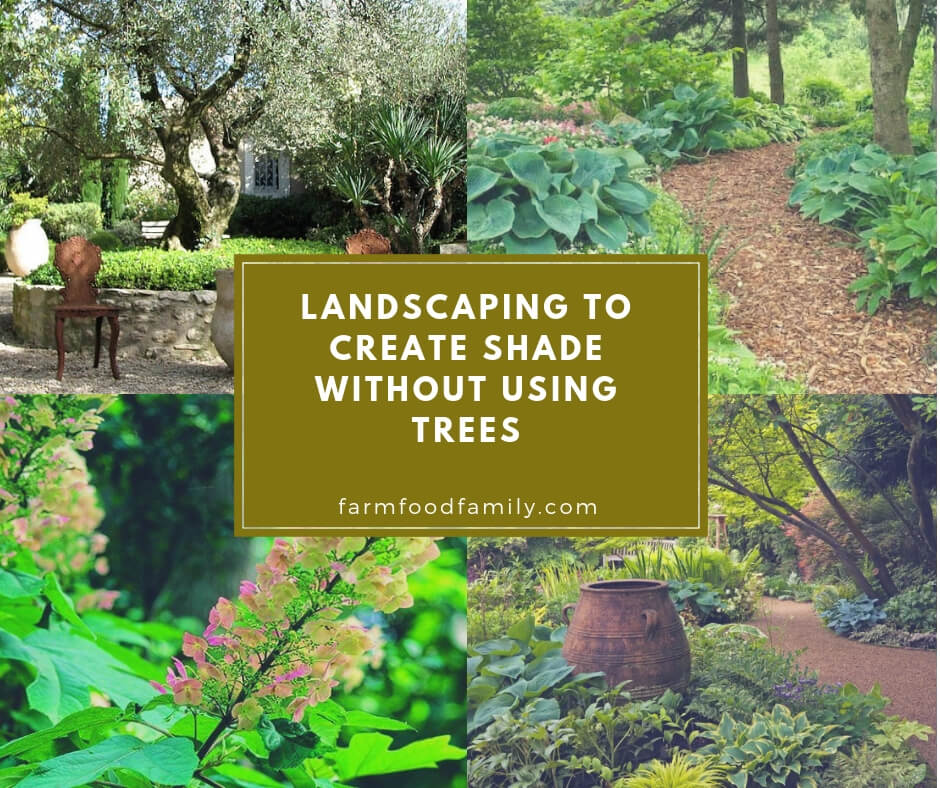Shade has cooling effect on a home and garden. When trees, the best sources of natural shade aren’t available or practical, there are alternative plants.
Shade is cooling and quieting in a yard or garden. It is the canopy from the sun. Trees offer shade but sometimes aren’t feasible to grow due to space, climate, landscape design, or other reasons.
Grass underfoot cools the ground but its shade options are limited. .Shrubs and vines along walls, fences, awnings, and gazebos, arches, and pergolas can create shade.
Considerations for Plant Selection to Create Shade

The advantage of creating shade as opposed to planting in the shade is light. Once shade is created, planting is influenced by the absence of light but in this situation the plants have light to grow.
- If shade is wanted all year round use evergreen plants. Shade needed only during summer months can make use of seasonal plants or deciduous shrubs.
- Consider the size of plant; the higher the plant, the more sun it displaces by shadow.
- Full grown plants replanted versus younger plants that adapt to the space and area are considerations for growth time and replant shock.
- Water restrictions from some areas impact the success of planting in the sun to create shade and when to plant.
- Native friendly plants help compliance to local ordinances and to weather extremes.
- Is the desire to attract or repel wildlife or birds? Seeds, berries, and flowers, can draw birds, butterflies and other critters.
- Consider scents and color for boundaries and shade.
Related: Dwarf evergreen shrubs for small gardens
You May Like These Shade gardening ideas
- Colorful Plants for Shade Gardening: Plants That Bloom in Shade
- Herb Plants for Shady Garden Areas: Garden Herbs that Grow in the Shade
- Best Shade Plants for Small North Facing Patios: Fabulous Gardening Ideas for Containers in Shady Areas
- Garden Shrubs to Grow as Shade Plants: A Selection of Evergreen and Flowering Shrubs for Shaded Areas
Vines to Create Shade in the Garden

Vines and bushes can grow along a wall. Walls can be placed at pre-determined times of day to catch shade at that time.
Enhance an overhanging windowsill or shade with a vine growing up it or by creating a living wall boundary out from it. Don’t totally obstruct airflow from AC units or views from windows.
- Have a vine shower down from a window overhang making a small cascade of shade within and up to the window.
- Combine vines to create thickness and increased shade.
- Vines can shade windows as well as areas of the home. Don’t allow attachment to the façade since eventually paint and siding can be chipped and worn away. Leaving air space between the vine and wall is recommended.
- Hydrangea in zones 4-10 grow and with flowers and leaves are capable of producing shade with the support of a trellis of fence.
- Grape vines with arbors produce beautiful speckled or complete shade
- Dutchmans Pipe is a strong climber able to attract butterflies.
- Jasmine is a fragrant vine that grows well with some physical support.
Shrubs Provide Localized Shade

Shrubs may not need the support vines do and can be free standing. Consider possibly any of those below.
- Elderberry known also as an antioxidant comes in several varieties that can create a nice shade bush with its feathery branches. It is a member of the honeysuckle family that is a vine that can create shade with growth.
- Banana plants are tropical but then more shade might be needed in warmer climes. It grows best in the southern part of the house where shade might also be needed most.
- Bamboo comes in many varieties, both bush and tree. Dense clumps of bamboo are attractive sturdy shade bush. Some varieties grow rapidly and need constant pruning. Some practically create fortress like shade and protection. Be sure to know what the end result of bamboo is will be
- Tea olive bush is a fairly rapid grower with a fantastic perfume–like scent.
- Palm fronds offer shade.


